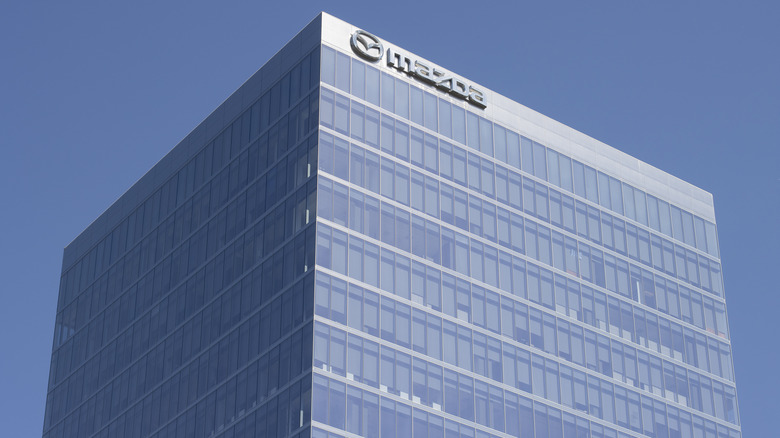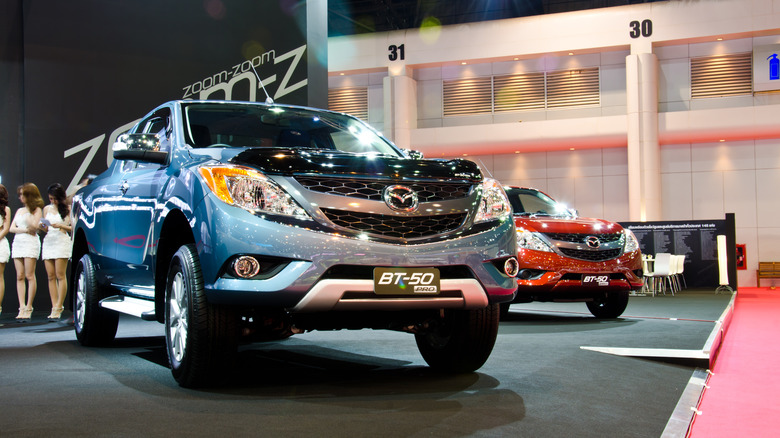When And Why Mazda Stopped Making Pickup Trucks In The US
Mazda is one of the world's most respected car companies and has been at the forefront of automotive technology, owing to its long-term development of the rotary engine and, more recently, its SkyActiv engine systems. Well known for the Miata and RX series of sports cars, Mazda has a considerable global presence, and has been a popular brand in the United States since starting operations in the country back in 1971. Despite its long presence in the U.S., Mazda ceased the production and sales of its pickup trucks for the American market in 2009.
The decision of Mazda to end the production and sales of its trucks in the U.S. was a result of the declining sales of its pickup trucks, which only totaled 1,319 units sold in 2008. This was a minuscule figure compared to its nearest competitor Ford, which sold 65,872 units of its Ranger in the same year. This low figure was part of Mazda's general issues in America, as it suffered a 14% decrease in total sales during 2008.
In addition to its dwindling sales, another reason for Mazda to stop making trucks was the 25% tariff on light trucks its pickups were subject to. Enacted in 1964, Proclamation 3564, also called the Chicken Tax, imposed a 25% tax on items including potato starch, dextrin, brandy, and light trucks. This meant that foreign car companies, including Mazda, had to pay a premium to sell pickups in the United States.
A long collaboration with Ford
Mazda had been selling pickup trucks in America for a long time, starting in 1972 with a small pickup truck called the B1600. During the same period, Ford wanted a smaller pickup to compete in the compact pickup market and decided to partner with Mazda. This venture resulted in the Ford Courier, which was simply a rebadged B1600 that was sold in the U.S. until 1982. Because of this partnership with Ford, Mazda could circumvent the expensive 25% tariff on light trucks by exporting the chassis without the truck beds attached, allowing Ford to complete its assembly domestically.
The initial venture between Ford and Mazda was a success, and Ford began investing more in Mazda in the 1970s and 1980s. In the mid-1990s, Mazda began to sell rebadged Ford Rangers in a reversal of the original 1970s agreement. The pickup, which became the fifth-generation Mazda B series, was sold from 1994 until 2009 in the United States.
The collaboration between Mazda and Ford slowed down starting in 2009, and Mazda halted U.S.-market pickup sales soon after. By 2014, Ford had fully divested all its interests in Mazda, and two years later, Mazda stopped the development and manufacture of pickup trucks as a whole and signed a deal with Isuzu to sell rebadged versions of its trucks.
The future of Mazda pickups
Despite the unavailability of its pickup trucks, Mazda continues to sell other vehicles in America, with eight models in the SUV and Crossover lineup and four passenger cars, including the Miata. Perhaps more importantly, Mazda has restarted development of its iconic rotary engine, which was last seen in the RX8. The rotary has been revived as a range extender for the MX-30 R-EV, an electric UV hybrid.
Six decades since its introduction, the Chicken Tax still affects the price of small trucks and is unlikely to be amended or repealed given the protection it provides to domestic manufacturers. This may be why Mazda has not resumed its truck sales in the U.S., but an alternative route that Mazda could potentially take to reintroduce its pickup trucks to America could be via hybrid models such as the CX9 hybrid SUV.
Today, Mazda is in a partnership with Isuzu, which has resulted in the third-generation Mazda BT-50, a pickup truck that shares its platform with the third-generation Isuzu D-Max. There have been many developments in the automotive industry since Mazda stopped selling its pickup in the United States, and it is possible in the future that Mazda can resume its pickup truck sales in the U.S., however, compelling reasons, including market demand and better commercial incentives, must be in place before this can happen.


